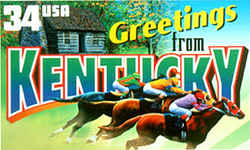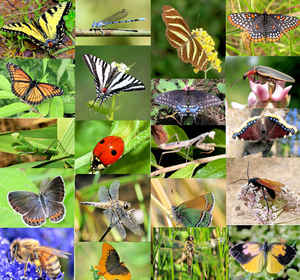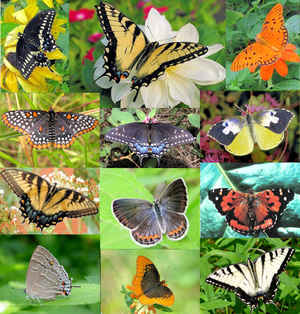
Kentucky Symbols
Kentucky State Butterfly
Viceroy Butterfly

(Basilarchia archippus)
Adopted on July 13, 1990.
The Viceroy Butterfly, (Basilarchia archippus,) was chosen as Kentucky State Butterfly on July 13, 1990 partly because of its striking resemblance to a large and better known species the Monarch Butterfly. The difference between the two is that the Monarch Butterfly is poisonous and the Viceroy Butterfly is not. The birds still will not eat the Viceroy Butterfly because it looks so much like the Monarch Butterfly.
Kentucky State Butterfly: Viceroy Butterfly

The Viceroy caterpillars can trick its predators. It can do this because it looks like bird droppings. The Viceroy Butterfly eats willows, poplars, and aspen leaves.
Closely resembling the toxic monarch and queen butterflies, the viceroy was once thought to be nothing more than a clever palatable mimic. The viceroy,
monarch and queen are all mahogany brown or orange with black wing veins and white spots, but the viceroy is the only one with a black band across
the middle of the hind wings; the monarch has bold black veins on all four wings; and the queen lacks black veins on the front wings, and its white
spots are much more obvious. Recent scientific research, however, has shown that the viceroy does in fact sequester toxic chemicals from its larval
host plants that make it very bad-tasting to a variety of predators. A classic example of "Mullerian mimicry", all three noxious species (the viceroy,
monarch and queen) gain protection by displaying a similar overall color pattern. Any predator attempting to eat any one member of the species trio
is likely to get a bad stomach ache or at least a bad taste in its mouth. When a similar looking butterfly is subsequently encountered, the predator
will probably avoid the meal, not wanting to make the same unpleasant culinary mistake again.
Widespread throughout much of the U. S. and Canada, the viceroy is a common garden visitor. Although capable of strong and rapid flight when disturbed,
the viceroy often lingers at flowers, rotting fruit, dung and sap, making it a highly visible and approachable butterfly. Especially prevalent along
streams, ponds and marshes, the viceroy typically does not stray far from its willow and aspen larval host plants.
Characteristics of the Viceroy Butterfly
The viceroy butterfly is dark orange with black veins. A row of white spots edge its wings. Its color and pattern mimics the monarch butterfly's pattern except for a black horizontal stripe that crosses the bottom of its back wings. The viceroy caterpillar is white and olive-brown.
Range
The viceroy can be found in most of the continental United States and in southern Canada and northern Mexico.
Habitat
The viceroy butterfly lives in meadows, marshes and swamps and other wet areas with willow, aspen and poplar trees.
Diet
The viceroy caterpillar eats the leaves of willow and poplar trees.
Life Cycle
The viceroy mates in the afternoon. The female lays her eggs on the tips of the leaves of poplars and willows. There are usually two or three generations of viceroys born each breeding season.
Behavior
The viceroy and monarch were once thought to exhibit Batesian mimicry where a harmless species mimics a toxic species. Studies conducted in the early 1990's suggest that the viceroy and the monarch are actually examples of Mullerian mimicry where two equally toxic species mimic each other to the benefit of each. Just goes to show you there's always something new to discover in the natural world!
Kentucky Law
The law designating the viceroy butterfly as the official Kentucky state butterfly is found in the Kentucky Revised Statutes, Title 1, Chapter 2, Section 2.083.
TITLE I - SOVEREIGNTY AND JURISDICTION OF THE COMMONWEALTH.
CHAPTER 2 - CITIZENSHIP, EMBLEMS, HOLIDAYS, AND TIME.
2.083 State butterfly.
The viceroy butterfly is named and designated as the state butterfly.
Effective: July 13, 1990
History: Created 1990 Ky. Acts ch. 78, sec. 1, effective July 13, 1990.
Taxonomic Hierarchy: Viceroy Butterfly
Kingdom: Animalia (Animals)
Phylum: Arthropoda (Arthropods)
Subphylum: Hexapoda (Hexapods)
Class: Insecta (Insects)
Order: Lepidoptera (Butterflies and Moths)
Superfamily; Papilionoidea (Butterflies and Skippers)
Family: Nymphalidae (Brush-footed Butterflies)
Subfamily: Limenitidinae (Admirals, Sisters)
Tribe: Limenitidini (Admirals, Sisters and Sailors)
Genus: Limenitis (Admirals & Viceroy)
Species: archippus (Viceroy - Hodges#4523)
Butterflies, and Bugs







